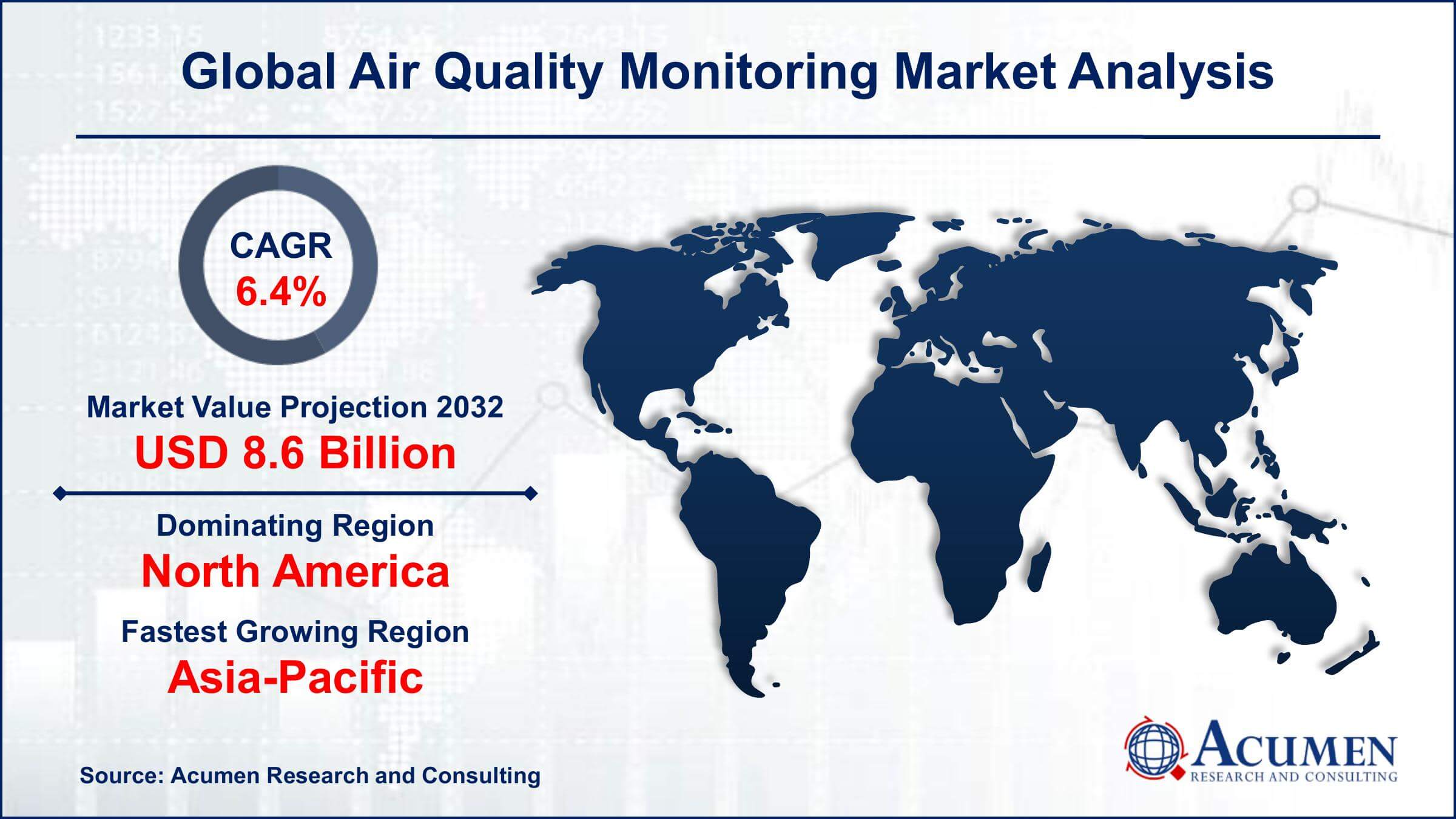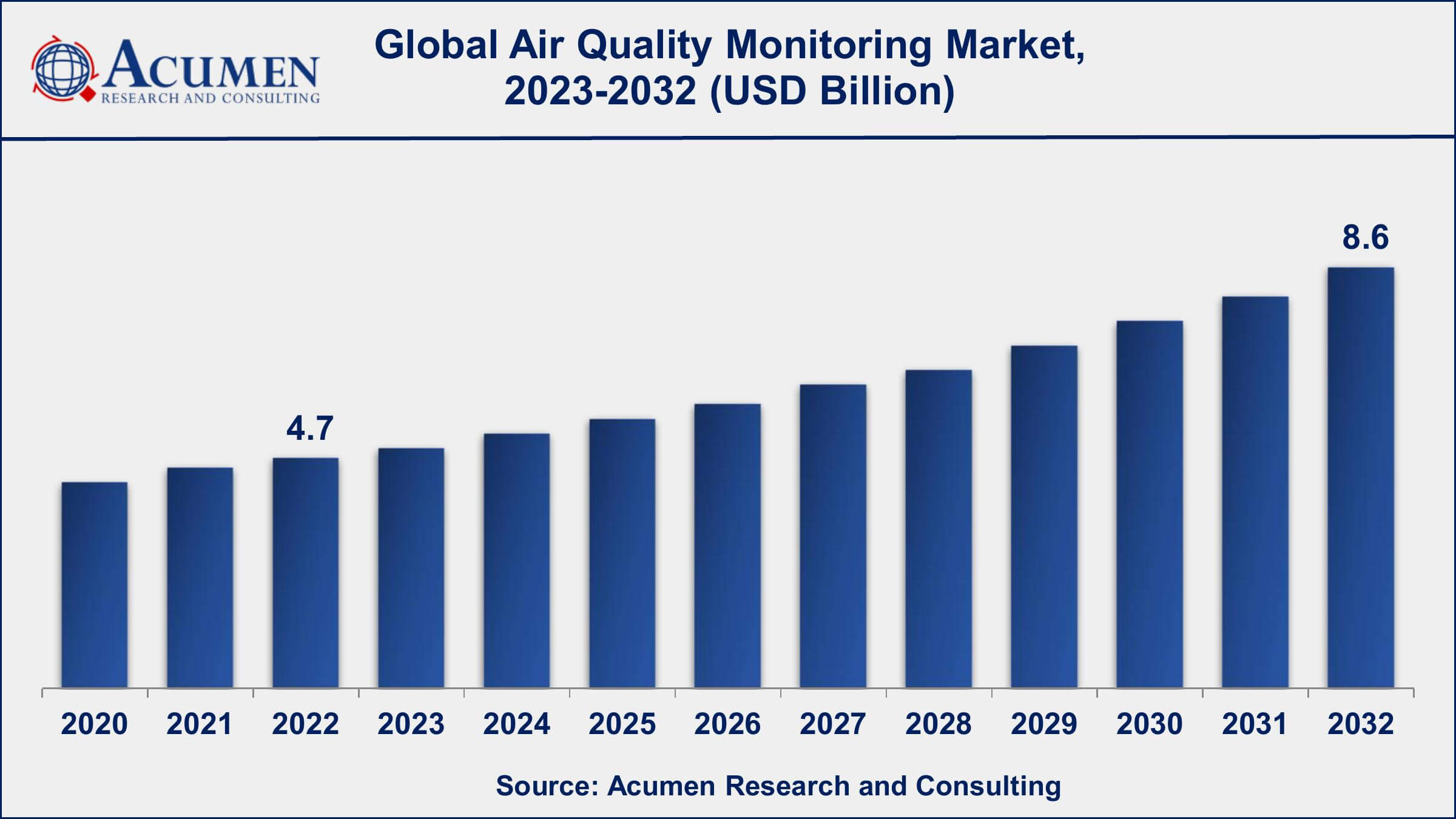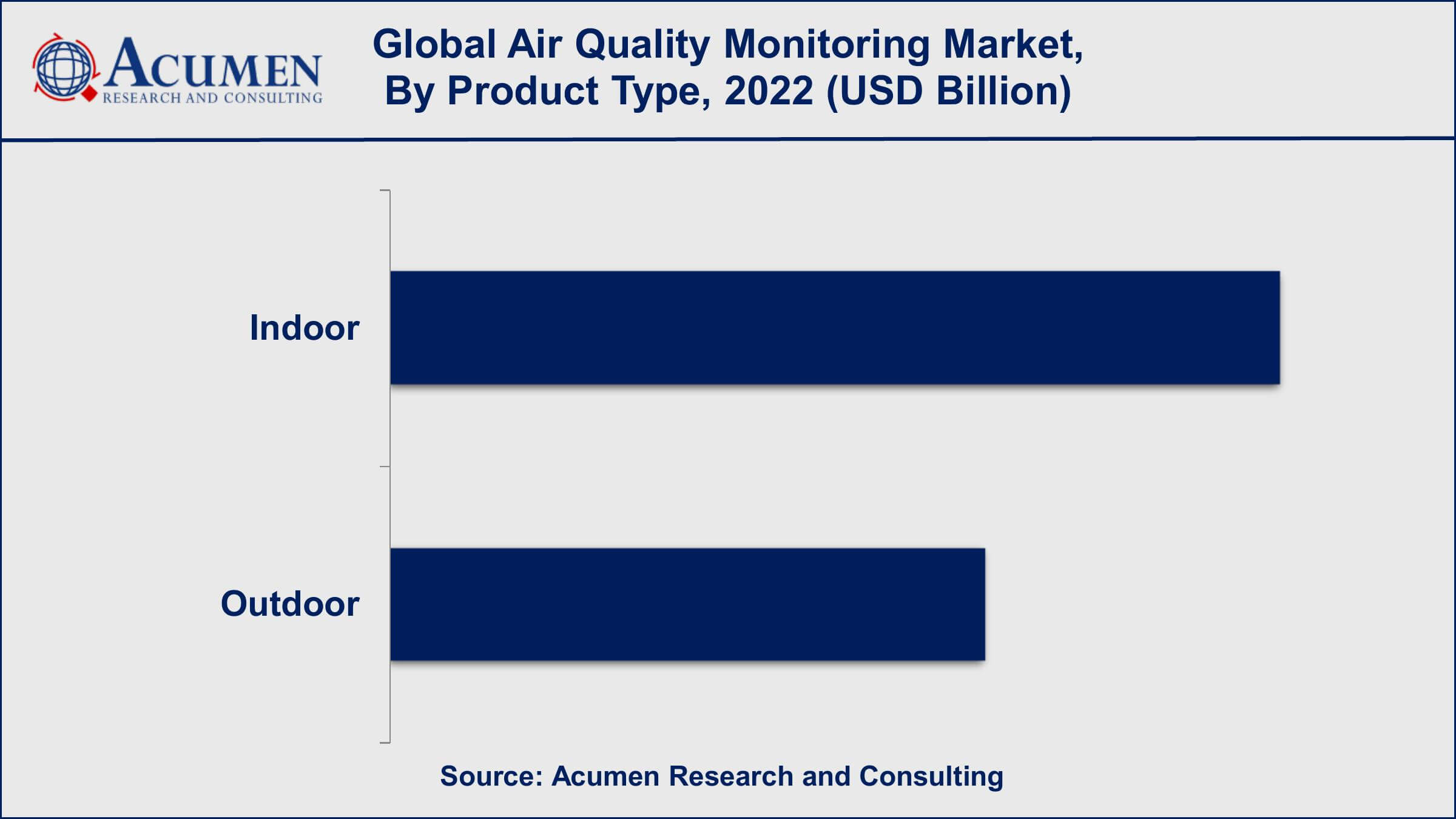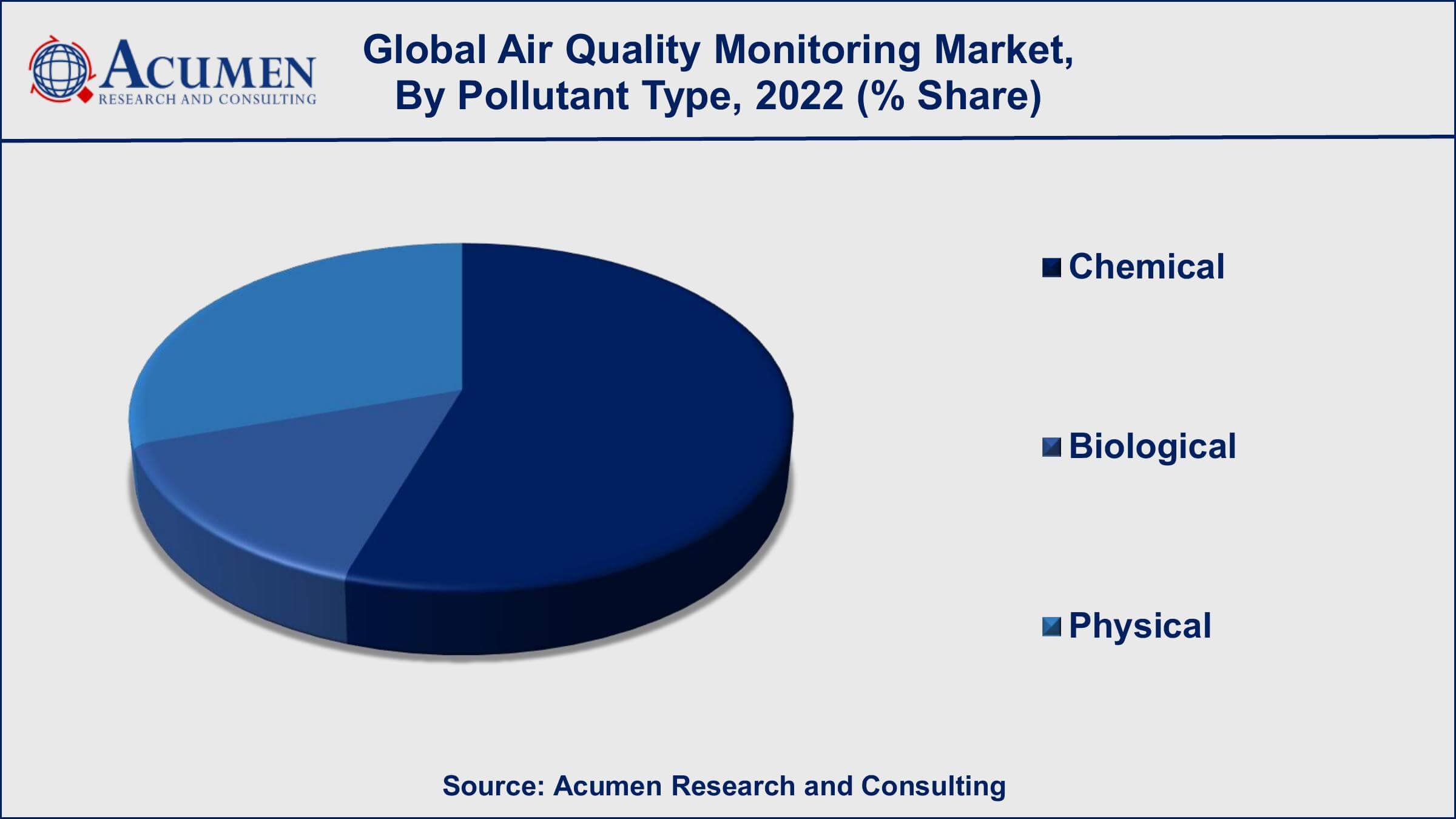September 2022
Air Quality Monitoring Market Size collected USD 4.7 Billion in 2022 and is set to achieve a market size of USD 8.6 Billion in 2032 growing at a CAGR of 6.4% from 2023 to 2032.
The Global Air Quality Monitoring Market Size collected USD 4.7 Billion in 2022 and is set to achieve a market size of USD 8.6 Billion in 2032 growing at a CAGR of 6.4% from 2023 to 2032.
Air Quality Monitoring Market Report Statistics

Air quality monitoring is a process of monitoring the quality of air in the surrounding environment and such monitors are developed in accordance with EEC directives that are relevant to monitoring emissions and controlling pollutants released from large combustion plants. Air quality monitors are responsible for maintaining the quality of air in closest spaces as well as open spaces. Demand for indoor air quality monitors is on the rise due to increasing awareness towards health and hygiene among consumers. Activities like painting and cooking can deteriorate the quality of air inside the house by releasing smoke and other particulate matters. DIY hobbies and cleaning can pave the way for introduction of Volatile Organic Compounds (VOCs) in households which has several negative effects on human health. Air quality monitors are gaining significant demand due to increasing cases of air pollution.
Further, air quality monitors are used to detect the intensity of pollutants such as carbon monoxide, nitrous oxide, sulfur dioxide and other harmful gases. Increasing air pollution levels across the globe is one of the key factors driving the demand for air quality monitors. Increasing vehicle population in some of the developed and developing countries such as the U.S., India, and China among others have resulted in increased levels of pollution released from the vehicles. Thus, demand for air quality monitors is on the rise and the impact of this driver is likely to remain high over the forecast period.

Global Air Quality Monitoring Market Dynamics
Market Drivers
Market Restraints
Market Opportunities
Air Quality Monitoring Market Report Coverage
| Market | Air Quality Monitoring Market |
| Air Quality Monitoring Market Size 2022 | USD 4.7 Billion |
| Air Quality Monitoring Market Forecast 2032 | USD 8.6 Billion |
| Air Quality Monitoring Market CAGR During 2023 - 2032 | 6.4% |
| Air Quality Monitoring Market Analysis Period | 2020 - 2032 |
| Air Quality Monitoring Market Base Year | 2022 |
| Air Quality Monitoring Market Forecast Data | 2023 - 2032 |
| Segments Covered | By Product Type, By Pollutant Type, By End-User Industry, And By Geography |
| Regional Scope | North America, Europe, Asia Pacific, Latin America, and Middle East & Africa |
| Key Companies Profiled | 3M Co., Emerson Electric Co., General Electric Company, Horiba, Ltd., Merck KGaA, Servomex Group Ltd., Siemens A.G., Teledyne Technologies Inc., Testo AG, and Thermo Fisher Scientific, Inc. |
| Report Coverage |
Market Trends, Drivers, Restraints, Competitive Analysis, Player Profiling, Covid-19 Analysis, Regulation Analysis |
Air Quality Monitoring Market Growth Factors
The rapid demand for air quality monitors is also attributed to the initiatives taken by regulating bodies regarding industrial emissions. The increasing levels of pollution have become a major concern for everyone due to the set-up of several new manufacturing plants across the globe. Additionally, high demand is also attributed to the increasing awareness towards health and wellness among the consumer and the urge to install air quality monitors inside their homes to maintain a clean environment.
However, high cost of such products is likely to inhibit the growth of air quality monitoring market. High cost of air quality monitoring devices is expected to restrict the market growth mainly in developing countries as the consumers in these countries refrain themselves from buying such products due to the higher cost. Less awareness towards the use of such products among the consumers is another major factor barring the growth of the market. However, rising industrialization in the developing countries is expected to be a suitable opportunity for the growth of this market. Penetration of new industries in the developing countries would result in the increase in level of pollution and therefore, would complement the growth of air quality monitoring market. Technological advancement is another suitable opportunity for the growth of air quality monitoring market. Increasing scope in the field of research and development would ensure the introduction of new and advanced air quality monitors in the future, thus complementing the growth of the market.
Air Quality Monitoring Market Segmentation
The worldwide air quality monitoring market is categorized based on product type, pollutant type, distributional channel, and geography.
Air Quality Monitoring Market By Product Type

According to the air quality monitoring market forecast, outdoor air quality monitoring segment will dominate the air quality monitoring market in terms of market size and revenue. Products in the outdoor air quality monitoring segment are intended to monitor air quality in open spaces such as cities, industrial areas, and transportation hubs. To measure contaminants such as particulate matter, nitrogen dioxide, ozone, and sulphur dioxide, these products typically employ a variety of sensors. They can be stationary or mobile, and the information they collect is typically used to monitor air pollution levels and inform air pollution prevention measures. The greater levels of air pollution in outdoor environments, the requirement for regulatory compliance and monitoring of pollution hotspots, and the growing number of initiatives by governments and organizations to monitor and mitigate outdoor air pollution all contribute to the larger market size of the outdoor air quality monitoring segment.
Air Quality Monitoring Market By Pollutant Type

Some of the most commonly monitored pollutants are chemical pollutants such as nitrogen dioxide, sulphur dioxide, ozone, and volatile organic compounds (VOCs). These pollutants are frequently linked to human activity, such as transportation, industry, and energy production. Pollen, mould spores, and bacteria are also commonly monitored biological pollutants. These pollutants, which are frequently found in indoor environments, can cause respiratory problems and allergies. Physical pollutants like particulate matter and noise are also frequently monitored. Particulate matter, which can be caused by industrial processes, transportation, and other human activities, can cause respiratory problems, whereas noise pollution can cause hearing loss and other health problems.
Air Quality Monitoring Market By End-User Industry
According to an Industry analysis of air quality monitoring, the government and academics sector is currently the largest end-user of air quality monitoring systems and is expected to continue to dominate the market in the coming years. Air quality monitoring systems are used by the government and academic institutions to collect data on air pollution levels and to notify regulatory policies and public health initiatives. These organizations are frequently in charge of monitoring air quality in cities and industrial areas, making them a significant source of demand for air quality monitoring systems. Government and academic institutions have an increased need for accurate and trustworthy air quality data, which encourages the creation of more advanced and precise monitoring systems. While the government and academic sectors dominate the market for air quality monitoring, other industries are also important end users. For example, the oil and gas industry uses air quality monitoring systems to monitor emission levels from their facilities and ensure compliance with regulations. Air quality monitoring systems are also used in power plants and commercial and residential buildings to ensure healthy indoor environments and to meet regulatory requirements.
Air Quality Monitoring Market Regional Outlook
North America
Europe
Asia-Pacific
Latin America
The Middle East & Africa
Air Quality Monitoring Market Regional Analysis
Geographically, the market is bifurcated into North America, Europe, Asia-Pacific, Middle East and Africa and Latin America. Increasing industrialization in the major countries in Asia-Pacific such as India, China and Japan among others would ensure steady growth of this market throughout the forecast period. Rising number of vehicles would also ensure the growth of this market during the forecast period.
Air Quality Monitoring Market Players
Some of the key players in the global air quality monitoring market include 3M Co., Emerson Electric Co., General Electric Company, Horiba, Ltd., Merck KGaA, Servomex Group Ltd., Siemens A.G., Teledyne Technologies Inc., Testo AG, and Thermo Fisher Scientific, Inc.
Looking for discounts, bulk pricing, or custom solutions? Contact us today at sales@acumenresearchandconsulting.com
September 2022
February 2024
July 2021
September 2024